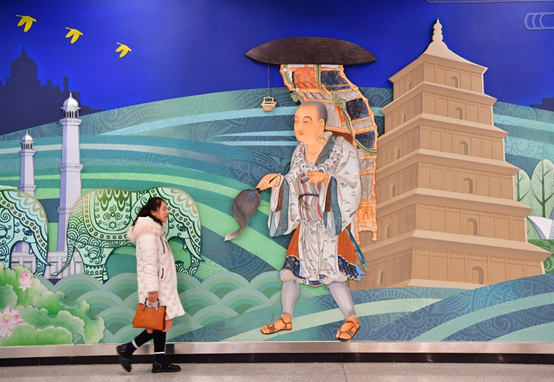

The city of Xi’an, capital of northwest China’s Shaanxi Province, which enjoys a long history and served as capital for 13 dynasties, has made effective exploration in building modernity while preserving historical legacy.

The photo shows the ancient city wall of Xi’an. (Photo: People’s Daily)
A recent piece of news announced by Shaanxi’s cultural relic authority triggered nationwide attention, that a ruin of ancient capital dating back to Qin Dynasty (221-206 BC) was unearthed during the construction of the Xi’an Metro Line 5. In order to protect the ruin and relics, the metro line may have to change its route.
It was not the first time that Xi’an found ancient ruins during subway construction. More than 200 pieces of cultural relics were unearthed during tunnel excavation of the Xi’an Metro Line 2. The route, passing through 57 cultural sites tracing from West Han Dynasty (206 BC-9 AD) to Ming Dynasty (1368-1644 AD), is nicknamed “the corridor of history”.
Apart from the metro, cultural relics are also discovered at many construction sites in the city.

A passenger walked by a culture wall at the Giant Wild Goose Pagoda station of the Xi’an Metro Line 4, Dec. 26, 2018. (Photo: Xinhua News Agency)
Shaanxi is home to 49,058 immovable cultural heritages, three of which are on the UNESCO's world cultural heritage list. In addition, 235 of them are key historical and cultural sites protected at the national level.
Facing the heavy and important task of protecting cultural relics while promoting urban construction, Xi’an made active attempts.
Rails of the metro system are paved 15 to 20 meters underground, in a bid to protect the ancient tombs and ruins which are usually buried in the layer within 5 meters from the surface level.
In addition, local cultural relic authority would also conduct lineside investigations and archaeological excavations before the construction of the metro lines.

Five Ukrainian tourists posed for a picture at the Bell Tower station of Xi’an Metro. They purchased tickets to the Giant Wild Goose Pagoda under the guidance of a volunteer named Luo Xin, Sep. 30, 2018. (Photo: Zhang Pengbin, Shen Li/ People’s Daily)?
Take the Xi’an Metro Line 4 as an example. Opened last year, it bypasses a number of protected historical and cultural sites, including the ruin of Daming Palace of Tang Dynasty (618-907 AD), the ruin of Chang’an city of Sui (581-618 AD) and Tang Dynasties, the site of the Xi’an Incident during the Anti-Japanese War, the ancient city wall of Xi’an, and the Giant Wild Goose Pagoda.
Besides, the metro constructors have also painted the walls inside the stations of the Line 4 with historical stories happened at each station or local cultural features, presenting a visual feast for citizens.
 Fire brigade in Shanghai holds group wedding
Fire brigade in Shanghai holds group wedding Tourists enjoy ice sculptures in Datan Town, north China
Tourists enjoy ice sculptures in Datan Town, north China Sunset scenery of Dayan Pagoda in Xi'an
Sunset scenery of Dayan Pagoda in Xi'an Tourists have fun at scenic spot in Nanlong Town, NW China
Tourists have fun at scenic spot in Nanlong Town, NW China Harbin attracts tourists by making best use of ice in winter
Harbin attracts tourists by making best use of ice in winter In pics: FIS Alpine Ski Women's World Cup Slalom
In pics: FIS Alpine Ski Women's World Cup Slalom Black-necked cranes rest at reservoir in Lhunzhub County, Lhasa
Black-necked cranes rest at reservoir in Lhunzhub County, Lhasa China's FAST telescope will be available to foreign scientists in April
China's FAST telescope will be available to foreign scientists in April "She power" plays indispensable role in poverty alleviation
"She power" plays indispensable role in poverty alleviation Top 10 world news events of People's Daily in 2020
Top 10 world news events of People's Daily in 2020 Top 10 China news events of People's Daily in 2020
Top 10 China news events of People's Daily in 2020 Top 10 media buzzwords of 2020
Top 10 media buzzwords of 2020 Year-ender:10 major tourism stories of 2020
Year-ender:10 major tourism stories of 2020 No interference in Venezuelan issues
No interference in Venezuelan issues
 Biz prepares for trade spat
Biz prepares for trade spat
 Broadcasting Continent
Broadcasting Continent Australia wins Chinese CEOs as US loses
Australia wins Chinese CEOs as US loses